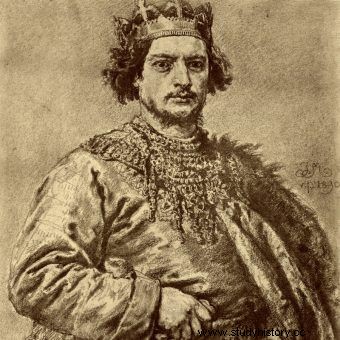
Bolesław the Bold according to Jan Matejko.
Bolesław the Bold
King of Poland of the Piast dynasty, the third crowned ruler of the state; also known as Bolesław Szczodry. He was born around 1042 as the eldest son of Kazimierz I the Restorer and the Russian princess Maria Dobroniega. Prince since 1058.
He received his royal title in 1076 from Pope Gregory VII, siding with him in the continent-tearing dispute with Emperor Henry IV. He pursued a policy of continuous wars, coming into conflict with Hungarians, Czechs and Ruthenians:for this reason, in later tradition, he was compared with the namesake and creator of the first Polish power, Bolesław the Brave. Like that ruler, he managed to take Kyiv and put his protégé on the Russian throne. This happened in the year 1069.
At the end of the 1870s, the king came into conflict with Stanisław, the bishop of Kraków. Contrary to later tradition, he did not murder a representative of the Church, but sentenced him to death by dismemberment. According to many historians, the dispute was not moral but purely political, and Bishop Stanisław was a representative of the camp opposing the royal government.
Bolesław the Bold was expelled from the country in 1079 in unknown circumstances. He went to Hungary, where he was soon murdered. The exact cause of his death is not noted in the sources. Power after Bolesław the Bold was taken over by his younger brother, Władysław Herman, perhaps involved in a plot against the ruler.
The nickname of Bolesław is a subject of controversy. He is now usually referred to as "The Generous." An analysis of the chronicle by Gall Anonymus shows, however, that this term is not necessarily justified, and the formerly popular term "Bold" may be more appropriate.
